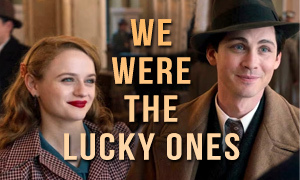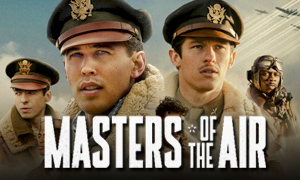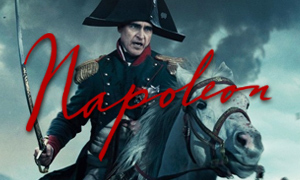Operation Mincemeat: History vs. Hollywood
Colin Firth
Born: September 10, 1960
Birthplace:
Grayshott, Hampshire, England, UK
Ewen Montagu
Born: March 19, 1901
Birthplace: London, England, UK
Death: July 19, 1985, London, England, UK
Bio: Peacetime Lawyer and Naval Intelligence Officer
Matthew Macfadyen
Born: October 17, 1974
Birthplace:
Great Yarmouth, Norfolk, England, UK
Charles Cholmondeley
Birthplace: UK
Bio: RAF Flight Lieutenant who Became a British Intelligence Officer
Kelly Macdonald
Born: February 23, 1976
Birthplace:
Glasgow, Scotland, UK
Jean Leslie
Born: November 20, 1923
Birthplace: Andover, Hampshire, England, UK
Death: April 03, 2012, England, UK
Bio: MI5 Clerk whose Photo was Placed on Glyndwr Michael's Corpse
Johnny Flynn
Born: March 14, 1983
Birthplace:
Johannesburg, South Africa
Ian Fleming
Born: May 28, 1908
Birthplace: Mayfair, London, England, UK
Death: August 12, 1964, Canterbury, Kent, England, UK
Bio: Naval Intelligence Officer and Novelist
Jason Isaacs
Born: June 6, 1963
Birthplace:
Liverpool, Merseyside, England, UK
Admiral John Godfrey
Born: July 10, 1888
Birthplace: Handsworth, England, UK
Death: August 29, 1970, Eastbourne, England, UK
Bio: Director of Naval Intelligence
Alex Jennings
Born: May 10, 1957
Birthplace:
Essex, England, UK
John Masterman
Born: January 12, 1891
Birthplace: Kingston upon Thames, England, UK
Death: June 6, 1977
Bio: Chairman of the Twenty Committee
Hattie Morahan
Born: October 7, 1978
Birthplace:
Lambeth, London, England, UK
Iris Montagu
Born: 1903
Death: 1999
Bio: Ewen Montagu's Wife
Mark Bonnar
Born: November 19, 1968
Birthplace:
Edinburgh, Scotland, UK
Jock Horsfall
Born: July 31, 1910
Death: August 20, 1949 (racecar crash)
Bio: MI5 Driver
Simon Russell Beale
Born: January 12, 1961
Birthplace:
Penang, Malaysia
Winston Churchill
Born: November 30, 1874
Birthplace: Blenheim Palace, UK
Death: January 24, 1965, Kensington, London, UK
Bio: British Prime Minister
What was Operation Mincemeat?
The Operation Mincemeat true story reveals that it was a secret ploy created by British intelligence in 1942-1943 to fool Nazi Germany into believing that the allies were planning to invade Greece, rather than their intended target, Sicily. To do this, they placed misleading documents on Glyndwr Michael's corpse, a homeless man who had taken his own life. They dressed him up as a fictitious Royal Marines officer named Captain William Martin. They dumped Glyndwr Michael's dead body (posing as Martin) into the sea so that the current would cause it to wash up on the southwestern coast of Spain, hoping that the Spaniards and Germans would believe he died in an air crash.
The British were confident that Spain, a country that was both in debt to Germany and ideologically sympathetic to the Axis Powers, would pass the phony intelligence to the Germans. Spain was also littered with Nazi spies, which improved the chances of the fake documents falling into German hands.
Did Ewen Montagu's wife and children flee Britain for the safety of America?
Yes. In the Operation Mincemeat movie, a formal dinner is held to bid farewell to Ewen Montagu's Jewish wife, Iris (Hattie Morahan), and their children, who are heading off to the safety of America out of fear of a potential German occupation of England. We learn that their marriage has been on the rocks for a while, largely due to Ewen's remoteness and time-consuming duty to his country. In real life, Montagu went to live with his mother after his wife and children left for America. Similar to what's seen in the film, he began to adopt a bachelor's lifestyle.
Is it true that Officer Charles Cholmondeley was assigned to MI5 because he didn't qualify to be an airman?
Yes. In researching the Operation Mincemeat fact vs. fiction, we learned that it was mainly Cholmondeley's poor eyesight that held him back from fulfilling his dream of being an airman. Though his more than six-foot-three-inch stature and size twelve feet would have likely also been a challenge to accommodate in a cockpit. He instead found himself working for the British security service, MI5. -BBC
Is Operation Mincemeat based on a book?
Yes. The Colin Firth movie is an adaptation of the 2010 nonfiction bestseller of the same name by British author and historian Ben Macintyre.
How long did British intelligence officers Ewen Montagu and Charles Cholmondeley spend developing Operation Mincemeat?
In researching how accurate is Operation Mincemeat, we discovered that Ewen Montagu and Charles Cholmondeley (pronounced 'Chumly'), portrayed by Colin Firth and Matthew Macfadyen in the movie, spent several months developing the plan. In October 1942, Officer Cholmondeley outlined the first version of the scheme on his own, which was codenamed Trojan Horse. Cholmondeley, a Royal Air Force flight lieutenant, suggested that they obtain a body from a London hospital and fill the lungs with water. Deceptive documents would be placed in an inside pocket and the body would be dropped into the sea by a Coastal Command aircraft. Upon being discovered, the enemy would believe that the officer had been aboard a plane that had "either been shot or forced down".
In November 1942, Cholmondeley's plan was rejected but considered to have potential. The Twenty Committee (an interdepartmental intelligence unit in charge of double agents) assigned Naval intelligence officer Ewen Montagu, a peacetime lawyer, to work with Cholmondeley to further develop the plan. Montagu was too old to fight on the battlefield. They spent months working on the backstory of their fictitious officer. It would take until mid-April of the following year before the plan was executed.
Did future James Bond author Ian Fleming come up with the idea that inspired Operation Mincemeat?
While conducting the Operation Mincemeat fact-check, we confirmed that Lieutenant Commander Ian Fleming (portrayed by Johnny Flynn in the film) had been the assistant to Rear Admiral James Godfrey (played by Jason Isaacs), the head of British naval intelligence. It is believed that Lieutenant Commander Fleming, not Godfrey, likely wrote the document known as the "Trout Memo," despite it being circulated in Godfrey's name. The memo, which was written in 1939, described 54 possible schemes that could be used to deceive the Axis Powers. Number 28 involved placing misleading documents on a corpse that would be discovered by the enemy. This idea was eventually developed into Operation Mincemeat by intelligence officers Ewen Montagu and Charles Cholmondeley.
While the book's author, Ben Macintyre, believes that the Trout Memo bore the hallmarks of James Bond author Ian Fleming, the future spy novelist appears to have been himself inspired by a similar scheme involving a corpse that was detailed in a book by Basil Thomson, another writer who had a connection to British intelligence. In the end, we can only speculate as to exactly how much of a hand Ian Fleming had in the memo's creation, but the movie's depiction is certainly believable, if not likely.
On a side note, Ian Fleming's boss, Admiral John Godfrey, became the inspiration for the fictional MI5 chief, "M," in Fleming's James Bond spy novels.
Did Glyndwr Michael kill himself with rat poison?
Yes. Without a job and homeless in the winter of 1943, Glyndwr Michael, 34, took his own life by consuming rat poison. It would have been an agonizing death for the Welshman. He was discovered on a cold January night in an abandoned warehouse in King's Cross, London and taken to St. Pancras Hospital where it took him more than two days to die. Glyndwr Michael's death certificate listed his official cause of death as "phosphorus poisoning. Took rat poison - bid [to] kill himself while of unsound mind." The coroner noted that Glyndwr Michael's corpse would be "removed out of England" for interment. The deceased never could have imagined prior to his death that he would play a pivotal role in turning the tide of the war. -BBC
How long was Glyndwr Michael's body kept on ice before it was used by British intelligence?
In researching the Operation Mincemeat true story, we learned that Glyndwr Michael's dead body was kept on ice for three months in the Hackney Mortuary in London. It was then transported to Spain's southern coast where it would play a key role in an intricate plot to trick the Nazis. Despite the coroner falsifying documents to suggest that Michael's family was okay with the use of his body, this was not the case. Both of his parents were no longer living and could not give their approval.
Did Glyndwr Michael's sister show up to claim his body?
No. The sister character Doris showing up in the Netflix movie is fictional and was invented by the filmmakers to emphasize that Glyndwr Michael had been a real person. "The sister showing up was a fictionalized element of the story," says screenwriter Michelle Ashford. "But he had some family, somewhere. So to make that person appear [is] representative of the fact that that guy came from somewhere" (LA Times). Ben Macintyre's book does mention Glyndwr having a younger sister named Doris, but that's the only truthful detail about the scene.
What items did British intelligence place on the corpse of Glyndwr Michael?
Posing as the fictitious Captain (Acting Major) William Martin of the Royal Marines, the items placed on the corpse had to be able to convince the Germans that his new identity was real. Dubbed "pocket litter" or "wallet litter" in intelligence circles, the items placed in his pockets and wallet included an identity card; a note from his bank manager explaining he was overdrawn; keepsakes from his fiancée (including love letters and a photo); and receipts and ticket stubs from different theaters and clubs. There was also a receipt for an engagement ring. Pictured below is the identity card produced for William Martin. A photo of MI5 case officer Ronnie Reed, who looked similar in appearance to Glyndwr Michael, was used to create the card.
A briefcase containing a top-secret letter between two British generals was chained to his wrist and marked "PERSONAL AND MOST SECRET". The letter designated Greece and Sardinia as the targets for the Allied invasion, with Sicily being a ruse. Of course, the actual plan was to invade Sicily, the perfect "soft underbelly" for Britain to push through into occupied Europe.
Did an MI5 clerk pose as the dead man's fake fiancée?
Yes. The Operation Mincemeat true story confirms that MI5 clerk Jean Leslie (portrayed by Kelly Macdonald in the movie) posed for a photo that was later used to depict Major William Martin's fake fiancée, who they named Pam. Jean Leslie's photo, which would have been considered somewhat alluring for the time, was planted on the corpse posing as Martin. It can be seen below. In real life, she didn't hand over the photo under the condition that she be given "a seat at the table." A sort of contest was held amongst the women in the offices and Leslie's photo won. She had sufficient security clearance and was partially included in the secret.
Was there a romance between Ewen Montagu and MI5 clerk Jean Leslie?
In researching Operation Mincemeat's historical accuracy, we determined that the love triangle appears to be true to some degree but was significantly embellished for the movie. The real Jean Leslie was single and only about 18 or 19 at the time, unlike her movie counterpart portrayed by Kelly Macdonald who was approximately twice that age at the time of filming. "We went to the cinema and we went dancing around somewhat," recalled Jean Leslie later in life. "[Ewen] was a much, much older man and I had other gentlemen around at that age. I was only about 18, 19. I suppose that I enjoyed the excitement of the whole thing. I would live the part of Pam, yes." Leslie gave Ewen Montagu a copy of the photograph that she had volunteered to be used in Operation Mincemeat. On his copy, she wrote, "Til death do us part, your loving Pam."
Director John Madden defended his decision to amplify the love triangle, telling USA Today that he didn't want a purely procedural plot. "We wanted to explore that idea of people coming together to create a larger fiction who are then changed and lost in the fiction they are creating," says Madden. Our Operation Mincemeat Love Story Video explains the historical accuracy of the movie's romance.
Did MI5 secretary Hester Leggett write the fictional love letters to be placed on the corpse?
Yes. MI5 head secretary Hester Leggett, who is portrayed by actress Penelope Wilton (Downton Abbey), wrote the fake love letters between the fictional Major William Martin and his invented fiancée Pam. In real life, the elderly Leggett was said to be stern and was unmarried. -BBC
Did Hester Leggett write to Ewen Montagu's wife, Iris?
No. There is no mention in Ben Macintyre's book of the head secretary, Hester Leggett, corresponding with Ewen Montagu's wife. In fact, unlike what's seen in the movie, Montagu wrote to his wife regularly. He even told her about his outings with the much younger Jean Leslie. While Montague did seem to have an infatuation with Leslie, his relationship with his wife wasn't as strained as it is in the movie.
Was Ewen Montagu's brother, Ivor, a suspected communist sympathizer?
Yes. In the film, Admiral John Godfrey (Jason Isaacs) asks Charles Cholmondeley (Matthew Macfadyen) to spy on Ewen Montagu (Colin Firth) to determine if Ewen's brother, Ivor, is passing secrets to the Russians. Charles entertains Godfrey's request mainly out of jealousy of Ewen over his budding romance with MI5 clerk Jean Leslie (Kelly Macdonald). Analyzing the Operation Mincemeat fact vs. fiction reveals that Ewen's younger brother, Ivor, was indeed a communist for some time.
In 1940, prior to the Soviet Union becoming an ally of Britain, Ivor was recruited by the Soviets to gather together a group of communist sympathizers. After Hitler invaded Russia and the Soviet Union aligned itself with Britain, both Ewen and Ivor were essentially working for the same side. Ivor, a filmmaker, film critic, and table tennis player, even made a film for Britain's Ministry of Information. It's true Ivor Montagu was spied on by MI5 in the early 1940s. Interestingly, MI5 grew highly suspicious of Ivor's passion for international ping-pong, believing that it was too eccentric of an interest for it not to be a cover for covert activities. They never found anything worth arresting him over.
Did they have trouble putting boots on the frozen feet of Glyndwr Michael's dead body?
Yes. An Operation Mincemeat fact-check confirms that as they were dressing the corpse of Glyndwr Michael in its military disguise as Major William Martin of the Royal Marines, Coroner Bentley Purchase, Ewen Montagu, and Charles Cholmondeley were unable to get the boots over the corpse's frozen feet. They used an electric heater to defrost the feet to the point they could get the boots on properly.
Did MI5 recruit racecar driver Jock Horsfall to drive the corpse to Scotland?
Yes. To conceal the body, it was inserted into a specially designed canister labeled "Optical Instruments." The canister was then bolted shut. It was loaded onto the souped-up van of MI5 chauffer and racecar driver Jock Horsfall, who was the fastest competitive driver in the country at the time. Horsfall, who was shortsighted, refused to wear glasses. He drove at breakneck speeds through the blackout, making his way to Scotland.
Accompanying Jock Horsfall on the journey were intelligence officers Ewen Montagu and Charles Cholmondeley, who rode in the back with the canister. At one point during the 500-mile journey that lasted through the night and into the next day, Horsfall failed to see a roundabout and the van careened straight over the grass circle. It was the closest that Montagu and Cholmondeley would come to death in action during WWII. Tragically, Horsfall himself died in a racing accident six years later in 1949. -BBC
Pictured below is Jock Horsfall enjoying a cup of tea during a break on the journey to Scotland. He is sitting on top of the canister containing the dead body disguised as William Martin.
Who found the corpse of "Major William Martin" after it was placed in the water near the Spanish coast?
The corpse, which the British had disguised as a phony Royal Marine officer named William Martin, was discovered by a local fisherman at approximately 9:30 a.m. on the morning of April 30, 1943, a mere five hours after it had been lowered into the water by crew members of the British submarine HMS Seraph commanded by Lieutenant Bill Jewell (pictured below, second from right). Just as British intelligence had hoped, Spanish soldiers took the body to the city of Huelva where it was turned over to a naval judge. The British vice-consul in the city, the reliable Francis Haselden, was officially informed of the discovery. He passed word along to the British Admiralty that the body and briefcase had been recovered by the Spaniards.
To play up the ruse, Haselden exchanged a series of pre-scripted diplomatic cables with his superiors back in England over the course of the next several days. The British knew that the Germans were intercepting the encrypted cables and that they could decipher them because they had already broken the encryption. The cables played up the importance of retrieving the briefcase that had been found with the body of Major William Martin.
Did Officer Charles Cholmondeley go with the crew of the HMS Seraph to drop the body into the sea?
No. In real life, Cholmondeley did not ride along on the submarine as he does in the movie. Both he and Ewen Montagu returned home to London after handing off the canister containing the body to the submarine crew on the west coast of Scotland. They also gave final instructions to the submarine's commander, Lieutenant Bill Jewell.
Did Captain David Ainsworth pleasure a man in order to ensure that the documents were seen by the Nazis?
No. In the film, Captain David Ainsworth (Nicholas Rowe), the British naval attaché in Madrid, seduces both men and women in order to make sure that the documents in the briefcase are seen by the Germans before it is returned to the British. Not only are these scenes entirely fictional, including the scene with the Spanish secret police officer, Colonel Cerruti, Captain David Ainsworth is an invented character.
Did Operation Mincemeat work?
Based on what we know about what happened after the plan was executed, it is believed that Operation Mincemeat was successful in tricking the Nazis. The false intelligence planted in a briefcase that was chained to the corpse posing as a fictitious British officer made its way to Adolf Hitler's desk via German Abwehr agents in Spain. The Abwehr agents (German military-intelligence agents) convinced the Spaniards to photograph the contents of the briefcase before returning it to the British.
Hitler evidently believed the information was reliable because he ordered ships, artillery, and an entire Panzer division made up of 90,000 soldiers to protect Greece, Sardinia and the Balkans from an Allied invasion. The Nazis were taken by surprise when the Allies instead invaded Sicily on July 10, 1943, taking the island with far fewer casualties than originally anticipated. It wasn't long before Mussolini was removed from power to the north.
Was Jean Leslie threatened by a spy named Teddy?
No. In the movie, a man who calls himself "Teddy" threatens Jean (Kelly Macdonald) in her apartment. She recognizes him from the club where she would meet with the others to discuss the secret corpse plan. Teddy claims to be a spy for an anti-Nazi faction in Germany. He tells Jean that he saw her photo amongst Major William Martin's papers and recognized her. She tells him that the deceased Major Martin was a spy who was traveling under an alias, and she leads him to believe that the classified documents that were in Major Martin's briefcase are real. Officers Ewen Montagu and Charles Cholmondeley hurry to visit Jean, making sure she's okay and expressing concern that Teddy may be a German spy who was lying about being part of an anti-Nazi group.
There was no Teddy in real life. He is a fictional character created to bring the perils of the war closer to the intelligence unit, creating a sense of immediate danger.
Was the work of the codebreakers at Bletchley Park instrumental in proving the Germans fell for the deception?
Yes. In exploring how accurate is Operation Mincemeat, we learned that Ultra decrypts of German messages (via the Enigma machine) revealed that Germany fell for the deception. One such communication was decrypted on May 14, 1943. It had been sent two days prior and warned that the Allies intended to target the Balkans for invasion. Ewan Montagu's team sent a telegram to Winston Churchill, stating, "Mincemeat swallowed rod, line and sinker by the right people and from the best information they look like acting on it."
What happened to the body of Glyndwr Michael?
The corpse was buried with full military honors on May 2, 1943 under the name Major William Martin in the Nuestra Señora cemetery in Huelva, Spain. The true identity of the body wasn't uncovered until 1996 when amateur historian Roger Morgan discovered evidence in the Public Record Office that the corpse was actually that of Glyndwr Michael, a Welshman. In 1998, after the British government confirmed the identity, an additional inscription was added to the headstone, which reads, "Glyndwr Michael Served as Major William Martin, RM".
Did the British place an eyelash within one of the folded letters in the briefcase to determine if it had been read?
Yes. The true story confirms that a single black eyelash was placed inside one of the letters in the briefcase. After the Spaniards returned the briefcase to the British, MI5 conducted a forensic examination of the contents and determined that the eyelash was missing, indicating that the documents had been removed and read.
The movie implies that the eyelash that was used was one that Ewen Montagu had removed from the cheek of Jean Leslie. This is pure movie fiction that was created to deepen her character's connection to the deception and to enhance the romance between Jean Leslie and Ewen Montagu.
Have any other movies been made about Operation Mincemeat?
Yes. The 1956 British film The Man Who Never Was is an adaptation of intelligence officer Ewen Montagu's 1953 memoir about the secret operation. If you watch that movie, be aware that it contains an entirely fictional subplot about a pro-German Irish spy who investigates the corpse's fake girlfriend, portrayed by Gloria Grahame.







